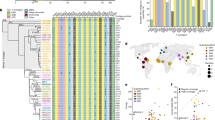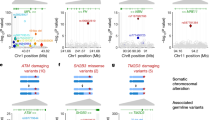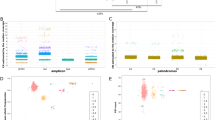Abstract
Many human Y-chromosomal deletions are thought to severely impair reproductive fitness, which precludes their transmission to the next generation and thus ensures their rarity in the population. Here we report a 1.6-Mb deletion that persists over generations and is sufficiently common to be considered a polymorphism. We hypothesized that this deletion might affect spermatogenesis because it removes almost half of the Y chromosome's AZFc region, a gene-rich segment that is critical for sperm production1,2. An association study established that this deletion, called gr/gr, is a significant risk factor for spermatogenic failure. The gr/gr deletion has far lower penetrance with respect to spermatogenic failure than previously characterized Y-chromosomal deletions; it is often transmitted from father to son. By studying the distribution of gr/gr-deleted chromosomes across the branches of the Y chromosome's genealogical tree, we determined that this deletion arose independently at least 14 times in human history. We suggest that the existence of this deletion as a polymorphism reflects a balance between haploid selection, which culls gr/gr-deleted Y chromosomes from the population, and homologous recombination, which continues to generate new gr/gr deletions.
This is a preview of subscription content, access via your institution
Access options
Subscribe to this journal
Receive 12 print issues and online access
$209.00 per year
only $17.42 per issue
Buy this article
- Purchase on Springer Link
- Instant access to full article PDF
Prices may be subject to local taxes which are calculated during checkout




Similar content being viewed by others
References
Kuroda-Kawaguchi, T. et al. The AZFc region of the Y chromosome features massive palindromes and uniform recurrent deletions in infertile men. Nat. Genet. 29, 279–286 (2001).
Yen, P. The fragility of fertility. Nat. Genet. 29, 243–244 (2001).
Skaletsky, H. et al. The male-specific region of the human Y chromosome is a mosaic of discrete sequence classes. Nature 423, 825–837 (2003).
Sun, C. et al. Deletion of azoospermia factor a (AZFa) region of human Y chromosome caused by recombination between HERV15 proviruses. Hum. Mol. Genet. 9, 2291–2296 (2000).
Blanco, P. et al. Divergent outcomes of intrachromosomal recombination on the human Y chromosome: male infertility and recurrent polymorphism. J. Med. Genet. 37, 752–758 (2000).
Kamp, C., Hirschmann, P., Voss, H., Huellen, K. & Vogt, P.H. Two long homologous retroviral sequence blocks in proximal Yq11 cause AZFa microdeletions as a result of intrachromosomal recombination events. Hum. Mol. Genet. 9, 2563–2572 (2000).
Repping, S. et al. Recombination between palindromes P5 and P1 on the human Y chromosome causes massive deletions and spermatogenic failure. Am. J. Hum. Genet. 71, 906–922 (2002).
Jobling, M.A. et al. Recurrent duplication and deletion polymorphisms on the long arm of the Y chromosome in normal males. Hum. Mol. Genet. 5, 1767–1775 (1996).
Bienvenu, T., Patrat, C., McElreavey, K., de Almeida, M. & Jouannet, P. Reduction in the DAZ gene copy number in two infertile men with impaired spermatogenesis. Ann. Genet. 44, 125–128 (2001).
de Vries, J.W.A. et al. Reduced copy number of DAZ genes in subfertile and infertile men. Fertil. Steril. 77, 68–75 (2002).
Fernandes, S. et al. High frequency of DAZ1/DAZ2 gene deletions in patients with severe oligozoospermia. Mol. Hum. Reprod. 8, 286–298 (2002).
Ewis, A.A., Lee, J., Shinka, T. & Nakahori, Y. Microdeletions of a Y-specific marker, Yfm1, and implications for a role in spermatogenesis. J. Hum. Genet. 47, 257–261 (2002).
Underhill, P.A. et al. Y chromosome sequence variation and the history of human populations. Nat. Genet. 26, 358–361 (2000).
Underhill, P.A. et al. The phylogeography of Y chromosome binary haplotypes and the origins of modern human populations. Ann. Hum. Genet. 65, 43–62 (2001).
The Y Chromosome Consortium. A nomenclature system for the tree of human Y-chromosomal binary haplogroups. Genome Res. 12, 339–348 (2002).
Kuroki, Y. et al. Spermatogenic ability is different among males in different Y chromosome lineage. J. Hum. Genet. 44, 289–292 (1999).
Hammer, M. et al. Hierarchical patterns of global human Y-chromosome diversity. Mol. Biol. Evol. 18, 1189–1203 (2001).
Ke, Y. et al. African origin of modern humans in East Asia: a tale of 12,000 Y chromosomes. Science 292, 1151–1153 (2001).
Jobling, M. & Tyler-Smith, C. The human Y chromosome: an evolutionary marker comes of age. Nat. Rev. Genet. 4, 598–612 (2003).
Reijo, R. et al. Diverse spermatogenic defects in humans caused by Y chromosome deletions encompassing a novel RNA-binding protein gene. Nat. Genet. 10, 383–393 (1995).
Vogt, P.H. et al. Human Y chromosome azoospermia factors (AZF) mapped to different subregions in Yq11. Hum. Mol. Genet. 5, 933–943 (1996).
Oates, R.D., Silber, S., Brown, L.G. & Page, D.C. Clinical characterization of 42 oligospermic or azoospermic men with microdeletion of the AZFc region of the Y chromosome, and of 18 children conceived via ICSI. Hum. Reprod. 17, 2813–2824 (2002).
Collins, F.S., Brooks, L.D. & Chakravarti, A. A DNA polymorphism discovery resource for research on human genetic variation. Genome Res. 8, 1229–1231 (1998).
Haldane, J.B.S. The rate of spontaneous mutation of a human gene. J. Genet. 31, 317–326 (1935).
Soucie, J.M., Evatt, B., Jackson, D. The Hemophilia Surveillance System Project Investigators. Occurrence of hemophilia in the United States. Am. J. Hematol. 59, 288–294 (1998).
World Health Organization. WHO laboratory manual for the examination of human semen and sperm-cervical mucus interaction (Cambridge University Press, Cambridge, New York, 1992).
Saxena, R. et al. Four DAZ genes in two clusters found in the AZFc region of the human Y chromosome. Genomics 67, 256–267 (2000).
Tilford, C. et al. A physical map of the human Y chromosome. Nature 409, 943–945 (2001).
Acknowledgements
We thank D. Altshuler, A. Chakravarti, A.G. Clark, G.Q. Daley, M.J. Daly, J.N. Hirschhorn, L. Kruglyak, V.K. Mootha, S. Paabo and D.E. Reich for comments on the manuscript; M.F. Hammer and P.A. Underhill for assistance with genealogical studies; T. Ogata and the Department of Endocrinology and Metabolism, National Research Institute for Child Health and Development, Japan, for support and advice; and C. Bruning, N.A. Ellis, S. Fallet, A. Garguilo, J. Gianotten, B.R. Gilbert, M.F. Hammer, W.A. Hogge, J. Hoo, T. Jenkins, K. Kepler, K. Monaghan, E. Pergament, B. Shapiro, M.C. Summers, U. Surti, L. Weiss and J. Weissenbach for DNA, cell and blood samples. This work was supported by the US National Institutes of Health, the Howard Hughes Medical Institute and the Academic Medical Center.
Author information
Authors and Affiliations
Corresponding author
Ethics declarations
Competing interests
The authors declare no competing financial interests.
Supplementary information
Rights and permissions
About this article
Cite this article
Repping, S., Skaletsky, H., Brown, L. et al. Polymorphism for a 1.6-Mb deletion of the human Y chromosome persists through balance between recurrent mutation and haploid selection. Nat Genet 35, 247–251 (2003). https://doi.org/10.1038/ng1250
Received:
Accepted:
Published:
Issue Date:
DOI: https://doi.org/10.1038/ng1250
This article is cited by
-
High incidence of AZF duplications in clan-structured Iranian populations detected through Y chromosome sequencing read depth analysis
Scientific Reports (2023)
-
CEP128 is involved in spermatogenesis in humans and mice
Nature Communications (2022)
-
Y chromosome structural variation in infertile men detected by targeted next-generation sequencing
Journal of Assisted Reproduction and Genetics (2021)
-
Cytogenetic analysis of 3387 umbilical cord blood in pregnant women at high risk for chromosomal abnormalities
Molecular Cytogenetics (2020)
-
The association of gr/gr deletion in the Y chromosome and impaired spermatogenesis in Bulgarian males: a pilot study
Middle East Fertility Society Journal (2020)



